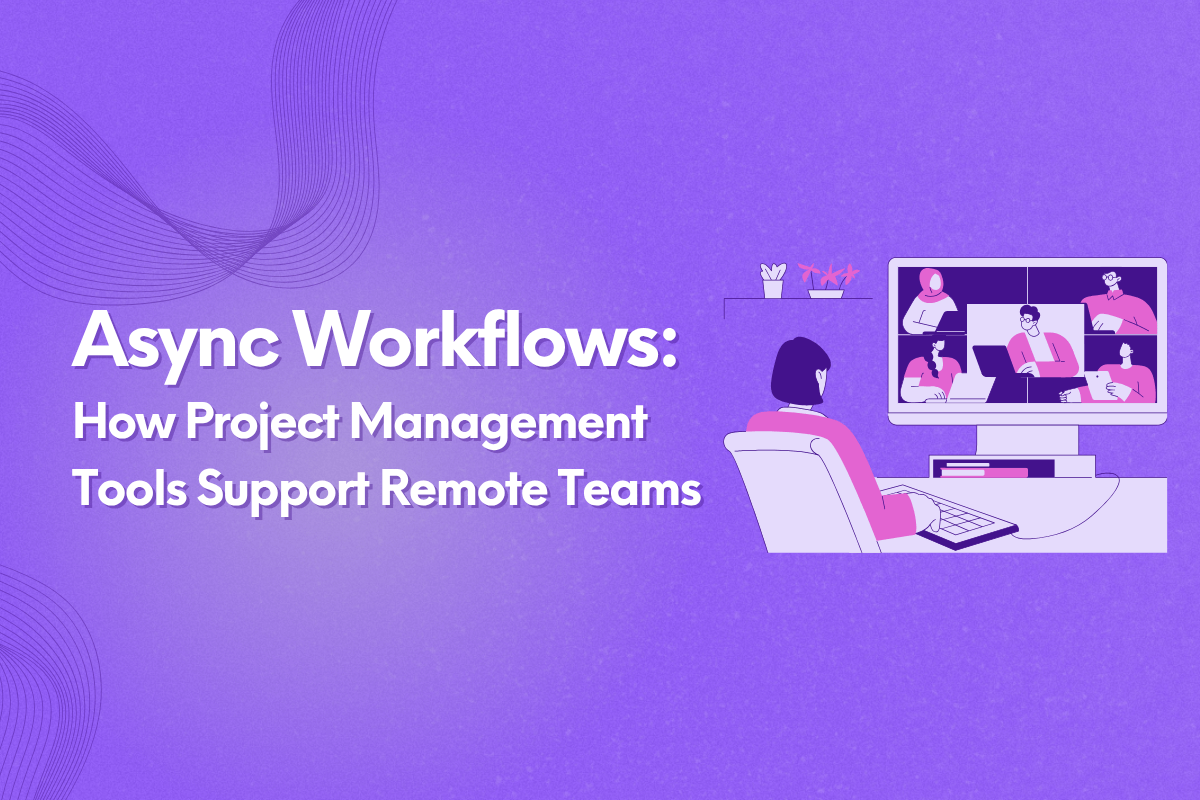The shift to remote and distributed teams has transformed how modern organizations operate. Flexibility, global talent, and work-life balance are major advantages. But they also come with one big challenge: coordination without real-time communication.
How do you keep projects moving forward when your team members aren’t online at the same time?
The solution is asynchronous workflows. A work style that prioritizes clear documentation, independent progress, and flexible collaboration. In this article, we’ll explore what async workflows are, why they matter for remote teams, and how project management tools, including Leiga, are helping teams master asynchronous collaboration.
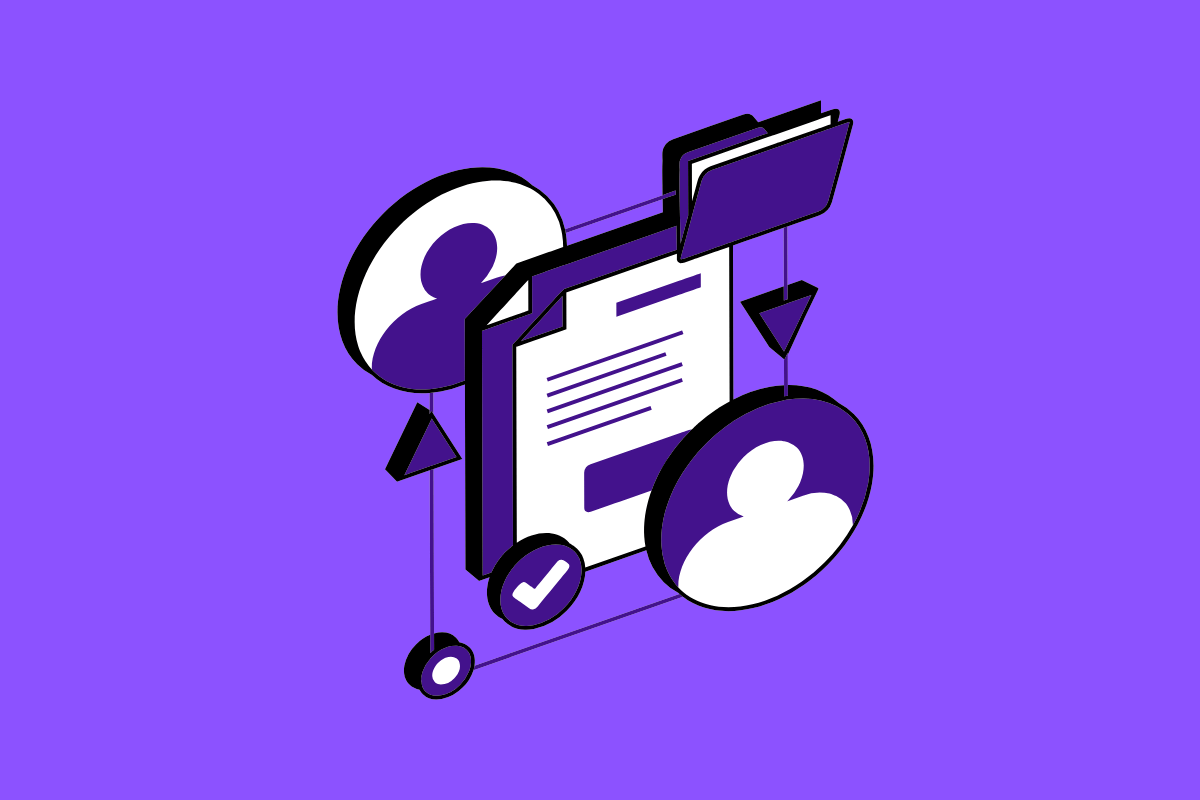
What Are Async Workflows?
Let’s first understand asynchronous workflows by comparing them to synchronous work.
Synchronous work means collaboration in real time, either through meetings, live chats, or calls.
Asynchronous work, on the other hand, occurs on each team member’s own schedule. Instead of live interactions, people communicate through written updates, recorded messages, or task comments.
Async workflows shift the focus from “Are you available now?” to “Is the work clear and documented enough to move forward independently?”
This works well for remote teams working across time zones or flexible hours. It means your projects keep moving, and you don’t have to wait for everyone to go online at the same time. Save your team’s time, cut down on meetings, and foster deeper focus.
Read More: The Dynamics of Dev Team Collaboration: Autonomy and Alignment
Why Async Work Matters for Remote Teams
As teams become more distributed, coordinating work in real time can be challenging and inefficient. Async workflows solve this problem by allowing team members to collaborate on their own schedules, ensuring productivity, inclusivity, and clear communication, no matter where or when they work.

1. Time Zone Flexibility
Async workflows make time zones irrelevant. A teammate somewhere in Asia can wrap up a task that a colleague in California will review the next morning. Work moves continuously without scheduling headaches.
2. Fewer Meetings, More Focus
Remote teams often suffer from meeting overload. Async workflows cut unnecessary calls and empower people to work in deep focus. With well-structured updates and clear documentation, everyone stays informed without interrupting their flow.
3. Inclusivity and Thoughtful Input
With async communication, everyone has a voice. Not just those who speak up quickly in live meetings. Team members can think through feedback and contribute thoughtfully. This leads to stronger ideas and decisions.
4. Documentation and Transparency
With written updates, decision logs, and recorded discussions, you create a natural record of progress. This transparency helps onboard new team members quickly while also ensuring that context is not lost when someone in the team is offline.
5. Sustainable and Scalable Collaboration
Synchronous work becomes more inefficient when your team grows and becomes more global. With async workflows, you can scale effortlessly while also keeping work transparent and moving without bottlenecks.
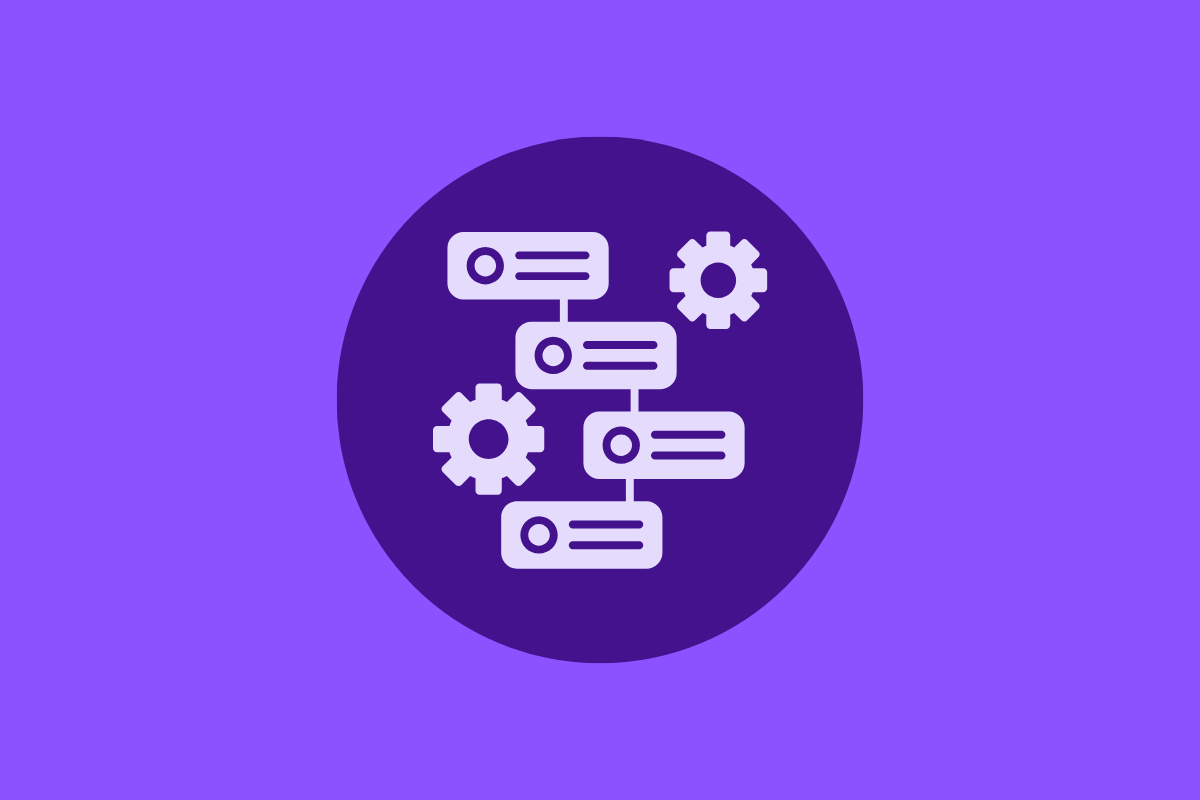
How Project Management Tools Enable Async Workflows
Async collaboration is not possible without the right foundation. Using modern project management tools provide the structure and visibility that can make asynchronous work effective.
Here’s how they help:
Centralized Task Management
With project management software, your team can assign, track, and update tasks in one place. Everyone can see tasks in progress, which ones are blocked, and what’s next with effective task management.
Context-Rich Communication
Get context for every task from comment threads, file attachments, and activity logs. This eliminates the need for repetitive check-ins. It also keeps discussions tied to specific tasks or actionable items.
Multiple Project Views
It’s easier for team members in any time zone to understand priorities at a glance when you use multiple project views. Boards, lists, calendars, and timelines help visualize work in different ways.
Automation & Workflow Rules
Projects move forward even when no one is watching with automation. Tasks can automatically advance between stages. You can also send automated updates or trigger reminders to relevant members. This keeps work flowing asynchronously.
Knowledge Integration
Developers now use connected tooling that you can integrate with docs, messaging apps, and emails. This helps you connect project data with documentation. Teams can find context without switching tools.
Read More: The Hidden Costs of Context Switching for Dev Teams
Transparent History & Versioning
Async teams rely on visible history. Teams can see who changed what, when, and why. When you use tools with version tracking, your team stays aligned even when conversations happen across different days.

Best Practices for Implementing Async Workflows
Even with great tools, success depends on how you use them. Here’s how to make async workflows work in your remote team:
1. Set Clear Expectations
Define how and when team members should respond, update tasks, and hand off work. For example, you can establish rules like:
“Non-urgent updates: within 24 hours”
“Task feedback: within 48 hours”
“Urgent issues: use the dedicated alert channel”
2. Document Everything
Use your project management tool or a linked workspace to capture key decisions, workflows, and FAQs. That way, teammates can find answers anytime without waiting for replies.
3. Use Templates for Consistency
Templates for task descriptions, status updates, and reports ensure consistency and reduce guesswork. Everyone knows what information to include when updating a task.
Read More: How Templates Streamline Project Planning and Task Management
4. Limit Live Meetings
Reserve real-time calls for strategic discussions, brainstorming, or team bonding, not routine check-ins. Many async-first teams have cut meetings by 70–80% after adopting structured updates.
5. Combine Async and Sync Wisely
Even async-first teams benefit from some overlap. Occasional synchronous sessions help reinforce culture, resolve blockers fast, and maintain human connection.
6. Lead by Example
Leaders must model async behavior, documenting decisions, writing updates, and respecting flexible hours. When leadership practices async communication, it becomes part of the culture.
Common Pitfalls (and How to Avoid Them)
Even the most well-intentioned async workflows can run into challenges. From unclear communication to cognitive overload. Recognizing these pitfalls early helps teams stay efficient and connected, rather than frustrated or lost in miscommunication. Here are some of the most common async mistakes remote teams face and how you can avoid them.
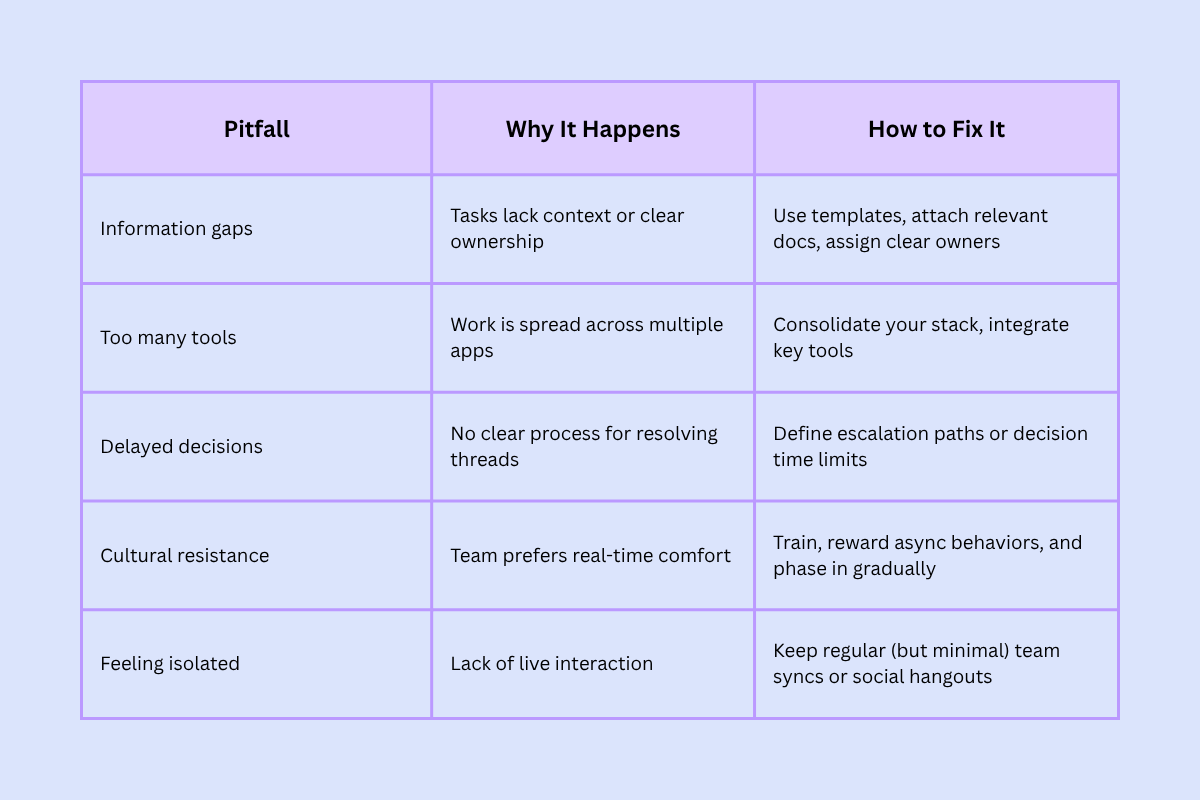
Async Transformation In Remote Teams
A fully remote developer team operating across time zones struggles with constant sync meetings. After shifting to async workflows using a project management platform, you can experience the following advantages.
- As much as 40% reduction in meetings
- 30% faster turnaround on deliverables
- Improved clarity due to written updates and shared templates
These are some tools and strategies that make async workflows effective.
- Project management tool for tracking deliverables
- Shared documentation hub for processes and templates
- Automated task workflows for reviews and approvals
- Weekly async updates (short written or recorded recaps)
The result: less burnout, better collaboration, and more focused workdays.
How Leiga Supports Async Workflows for Remote Teams
Leiga is designed with the future of work in mind, flexible, automated, and collaboration-friendly. For teams embracing async workflows, Leiga provides everything you need to stay aligned without constant check-ins.

Here’s how Leiga empowers asynchronous collaboration:
1. Task Visibility Across Time Zones
Leiga’s intuitive task boards let everyone see what’s happening — no need to ask for updates. Tasks, due dates, and priorities are always visible, keeping remote teams on track 24/7.
2. Automations That Keep Work Moving
Leiga automates repetitive steps so projects don’t stall while someone’s offline. Tasks can shift stages, trigger notifications, or assign reviewers automatically, maintaining flow around the clock.
3. Centralized Communication & Context
Every task in Leiga contains its full conversation history, attached files, and related documents. This means no chasing messages across apps. Everything your team needs is in one place.
4. Flexible Views for Every Workflow
Leiga adapts to your team’s preferences. Whether it’s lists, Kanban boards, or timelines. Members can view projects in the format that suits their workflow best. This is a huge advantage for async coordination.
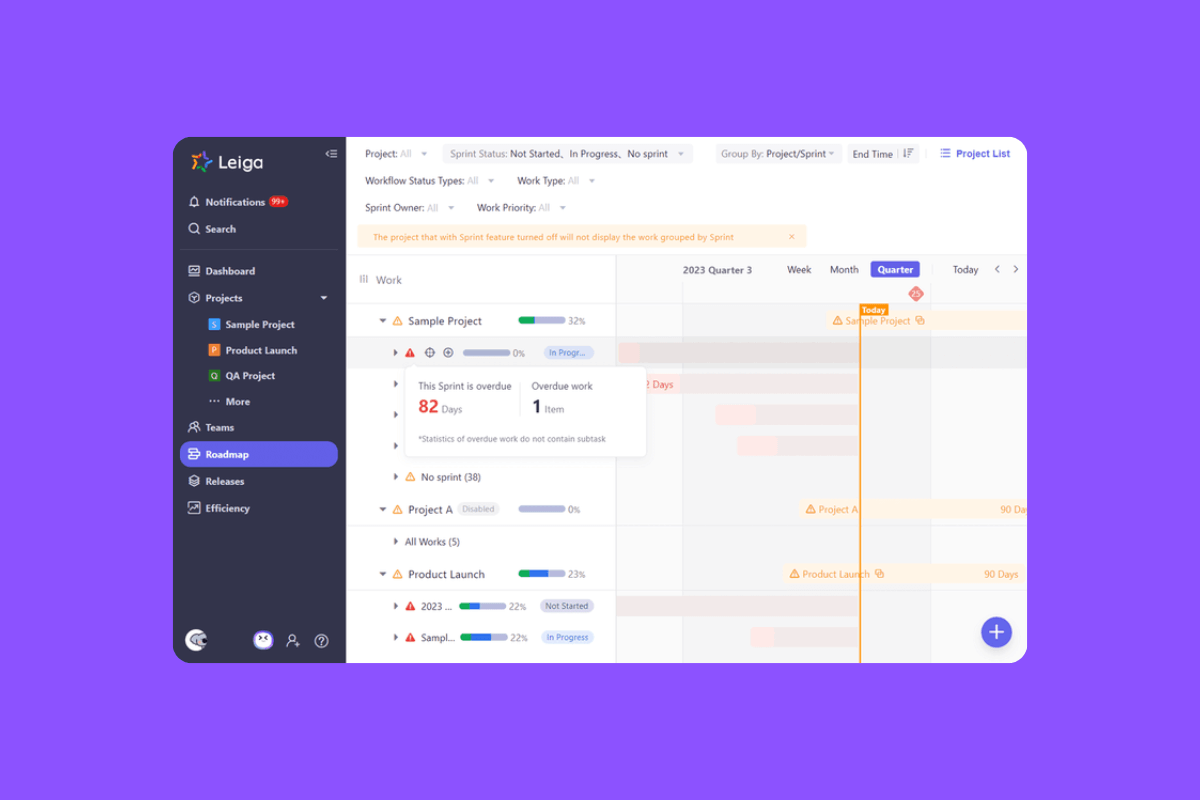
5. Integrations for Seamless Collaboration
You can integrate the tools your team uses with Leiga. From document platforms, developer tools, or communication channels. This makes sure that no context gets lost between tools.
6. Custom Templates for Clarity and Consistency
You can create and reuse templates for recurring projects with Leiga. Templates help ensure consistent structure and expectations. Async work thrives when team members follow the same clear format.
7. Analytics and Accountability
Project managers can track progress without micromanaging. Leiga’s dashboards show what’s on track, what’s blocked, and which members are responsible. Project data are updated automatically.
Read More: Smarter Project Reports with AI: Turning Every Update into Actionable Insight
In short, Leiga helps remote teams turn asynchronous workflows into an organized, self-sustaining system. One that prioritizes clarity, automation, and autonomy over endless meetings.

Getting Started with Async Workflows in Leiga
If your team is ready to make the shift, start small:
- Identify one recurring process (like weekly updates or content reviews).
- Move it into Leiga with clear task ownership, templates, and automation.
- Replace the meeting with async updates — written or recorded.
- Gradually expand the same system to other workflows.
You’ll quickly notice fewer interruptions, clearer communication, and more productive focus hours.
Asynchronous workflows aren’t just a remote work trend. They’re the foundation of how modern teams operate effectively across time zones. With the right project management tool, async collaboration can eliminate meeting overload, enhance transparency, and empower teams to work smarter.
Leiga makes this transformation seamless. By combining visibility, automation, and flexible collaboration features, it helps remote teams move from “always online” to “always aligned.”
In a world where time flexibility is as valuable as location flexibility, async workflows are the key to building truly global, efficient, and empowered teams. Experience seamless collaboration powered by Leiga. Try it for free today.
- Streamline Your Workflow with Leiga
- Effortlessly automate tasks
- Boost productivity with AI insights
- Free forever — elevate project management
